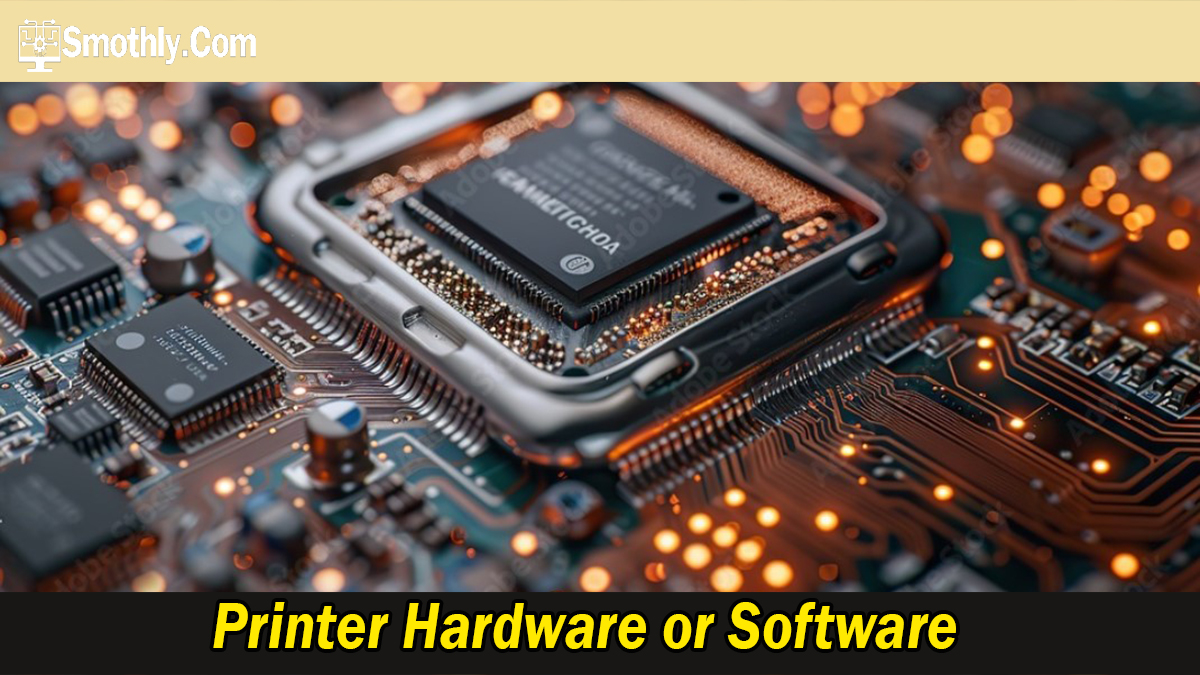Printer hardware or software are integral components of any printing system, each playing a crucial role in the overall functionality and performance. While printer hardware encompasses the physical components like printers, cartridges, and paper trays, printer software refers to the programs and drivers that enable communication between the computer and the printer.
Effective management and understanding of printer hardware and software are essential for optimizing printing processes and ensuring smooth activities in both home and office environments. This guide explores the key differences, features, and benefits of printer hardware and software, providing insights into how these components work together to deliver high-quality printouts and enhance productivity.
Types of Printers
Printers come in various types, each suited to different needs and environments:
- Inkjet Printers: Ideal for vibrant color printing and photo printing.
- Laser Printers: Known for high-speed printing and crisp text quality, suitable for offices.
- All-in-One Printers: These devices combine the functions of printing, scanning, copying, and occasionally faxing into a single unit.
- Dot Matrix Printers: Utilize impact printing technology, suitable for printing invoices and multipart forms.
- 3D Printers: Create three-dimensional objects layer by layer, used in prototyping and manufacturing.
Printer Hardware Components
Printer hardware encompasses physical components that make up the device:
- Printing Mechanism: Consists of parts such as paper feed mechanisms, ink or toner cartridges, and print head.
- Paper Handling: Paper trays, rollers, and output trays.
- Connectivity Options: USB, Ethernet, wireless connectivity modules.
- Control Panel: User interface for modifying settings and interacting with the user.
Installation and Setup of Printer Hardware
Installing printer hardware involves several straightforward steps to ensure proper functionality:
- Unboxing and Assembly: Remove packaging materials and assemble any detachable parts as per the manufacturer’s instructions.
- Power and Connectivity: Connect the printer to a power source and choose a suitable connectivity option (USB, Ethernet, wireless).
- Ink or Toner Installation: Install ink cartridges or toner cartridges as directed by the manufacturer.
- Loading Paper: Tilt paper trays to accommodate the right kinds and sizes of paper.
- Driver Installation: Install printer drivers either from a provided installation CD/DVD or download the latest drivers from the manufacturer’s website.
- Network Setup (if applicable): Configure network settings for printers with wireless or Ethernet connectivity.
Importance of Printer Hardware
Printer hardware plays a crucial role across various sectors due to its importance. These are given below :
-
Document Production: Printer hardware is essential for producing hard copies of documents, reports, presentations, and other materials. It facilitates the transfer of digital information into tangible, shareable formats.
-
Accessibility: Printers provide convenient access to information for individuals and teams. They enable quick dissemination of printed materials, which is particularly important in educational settings, offices, and business environments.
-
Versatility: Modern printer hardware supports a wide range of media types and sizes, from standard A4 documents to specialized formats like envelopes and photo paper. This versatility accommodates diverse printing needs across different industries.
-
Quality and Precision: High-quality printer hardware ensures accurate reproduction of text, images, and graphics. This is crucial for applications requiring detailed and precise output, such as graphic design, photography, and architectural drawings.
-
Productivity Enhancement: Efficient printer hardware contributes to improved workflow and productivity. It reduces turnaround times for printing tasks, allowing organizations to meet deadlines and operational goals effectively.
Printer Software Functionalities
Printer software refers to the programs and applications that manage and control printing operations:
- Printer Drivers: Software that facilitates communication between the printer and computer or device.
- Management Utilities: Tools for monitoring printer status, managing print queues, and configuring settings.
- Firmware: Software embedded in the printer that controls its operations and performance.
- Printing Applications: Software for specific printing tasks, such as photo editing software or document management tools.
- Operating System Integration: Native support and compatibility with various operating systems (e.g., Windows, macOS, Linux).
Why Printer Software is Essential
Printer software plays a critical role in enhancing functionality and usability:
- Configuration and Settings: Customise print quality, paper size, and other parameters.
- Print Job Management: Monitor print queues, prioritise jobs, and manage multiple print requests.
- Security and Firmware Updates: Patches and firmware updates help guarantee printer security.
- Compatibility: Ensure compatibility with various devices and operating systems for seamless printing experiences.
How To Install Printer Software
Following these steps, you can effectively install or update printer software to maximize performance, enhance functionality, and ensure reliable printing for various tasks in education, business, and creative industrie
1. Download from Manufacturer
- Visit the official website of your printer manufacturer. Navigate to the support or drivers section and locate your printer model. Download the latest drivers and software compatible with your operating system (OS).
2. Installation Process:
- Once downloaded, open the installer file.
- Follow the on-screen prompts to begin the installation process. This typically involves agreeing to terms and conditions and choosing installation options.
- Connect your printer to the computer when prompted. Ensure the printer is powered on and properly connected via USB, network, or wireless connection.
3. Configuration:
- After installation, launch the printer software or driver interface.
- Customize settings such as paper size, print quality, and default preferences based on your printing needs and environment.
- Configure additional features like duplex printing, color management, or advanced print settings as required.
4. Testing and Calibration:
- Print a test page to verify that the printer is installed correctly and functioning properly.
- Check for any alignment issues or color discrepancies and adjust printer settings or perform calibration if necessary.
- Ensure all features like scanning, copying (if applicable), and network printing (if applicable) are working as expected.
5. Updates and Maintenance:
- Periodically check for updates to the printer software and drivers on the manufacturer’s website.
- Install updates to ensure compatibility with the latest OS versions and to access new features or performance improvements.
- Regularly clean the printer hardware, such as printheads and rollers, to maintain print quality and prevent issues like paper jams or smudges.
Importance of Printers software
Printer software plays a crucial role in ensuring efficient and effective printing operations. Here are some key aspects highlighting its importance:
-
Driver Management: Printer software includes drivers that facilitate communication between the computer and the printer hardware. These drivers ensure compatibility and enable the computer to send print commands correctly. Without the proper driver, a printer cannot function with a computer, making printer software essential for installation and operation.
-
Print Management: Printer software often includes utilities for managing print jobs. This can include features like job queues, print scheduling, and prioritization. Such management capabilities are crucial in environments where multiple users share a printer or when printing large volumes of documents.
-
Configuration and Settings: Printer software allows users to configure various settings such as print quality, paper size, orientation, and more. Advanced settings may also include options for duplex printing (printing on both sides of the paper), color management, and toner/ink usage optimization. These settings help tailor the printing process to specific needs and save resources.
-
Troubleshooting and Maintenance: When issues arise with printing, printer software often provides diagnostic tools and troubleshooting guides. This helps users identify and resolve common problems such as paper jams, connectivity issues, or driver conflicts. Maintenance tasks such as updating firmware or cleaning print heads may also be managed through printer software.
-
Enhanced Functionality: Some printer software packages offer additional features like scanning, faxing, and document management. These functionalities expand the versatility of the printer beyond basic printing tasks, providing more value to users and organizations.
-
Security: Printer software may include security features such as user authentication, encryption of print data, and secure printing options. These are particularly important in environments where sensitive or confidential information is regularly printed.
-
Remote Management: Many modern printer software solutions support remote management capabilities. This allows administrators to monitor printer status, update settings, and troubleshoot issues from a central location. Remote management is especially valuable in large organizations with multiple printers distributed across different locations.
Conclusion
printer hardware and software are integral components of efficient printing operations. Understanding their roles, functionalities, and installation procedures empowers users to maximise productivity and achieve optimal print quality. Whether selecting a printer type, installing hardware components, or updating software, informed decisions lead to smoother printing experiences across diverse applications.By leveraging the capabilities of both printer hardware and software, users can meet their printing needs effectively, from basic document printing to intricate creative projects and professional-grade outputs.Learn More.
FAQs about Printer Hardware or Software
A keyboard is hardware, providing physical input to computers.
Yes, printer software (drivers and utilities) is essential for communication and control.
Yes, software updates improve performance, security, and compatibility.
Hardware processes physical tasks (like printing) faster than software manages digital operations.
Windows 7 is an operating system software developed by Microsoft.


